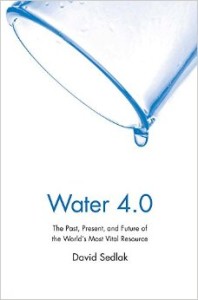Water 4.0: The Past, Present, and Future of the World’s Most Vital Resource
by David Sedlak, 2014
Interesting book about the history of water management, but I’m not sure if I buy the picture of the future. The first water revolution was Rome installing aqueducts to import freshwater to a city without enough of its own water. The second water revolution was chlorine and other treatments to disinfect tap water. The third water revolution was treating sewage water prior to releasing it to the wild or re-using it. The book argues that scarcity of water and climate change are pushing us to a fourth revolution, which may be true. However, I’m not sure if I buy these possible steps forward (the second option seeming especially unlikely):
In terms of water supply, the first version of Water 4.0 will look a lot like the upgraded, centralized systems that are emerging in Singapore and the water-stressed cities of Southern California, Australia, and Israel. As part of this approach, imported water will be supplemented or replaced by desalination and potable water recycling employed in conjunction with a full arsenal of policies designed to incentivize water conservation. Waste treatment will also look a lot different in this version of Water 4.0: centralized sewage treatment plants will evolve from a means of protecting surface waters from pollution to systems that recover water, energy, and nutrients from sewage…
The other version of Water 4.0 takes a more radical approach to urban water by pushing the responsibility for acquisition, treatment, and management of water back to the individual household or neighborhood. In the distributed version of Water 4.0, a shift in public attitudes will make it possible to reduce consumptive water use by around 75% through the installation of ultraefficient appliances and elimination of wasteful forms of outdoor water use. In the distributed water future, landscape irrigation with drinking water will be unthinkable, and rooftop rainwater collection tanks, rain gardens, and household wells will be common features of housing developments. In areas where the conditions are right, housing developments will operate without help from the expensive and difficult-to-maintain centralized water infrastructure…
Can you imagine relying upon your shoddy apartment management company or home owner’s association to supply you with drinking water? Sounds problematic.
